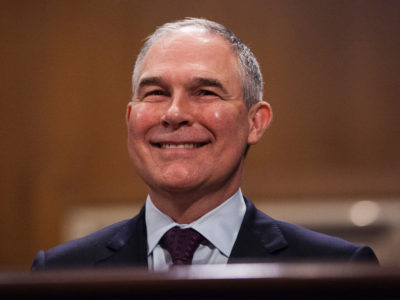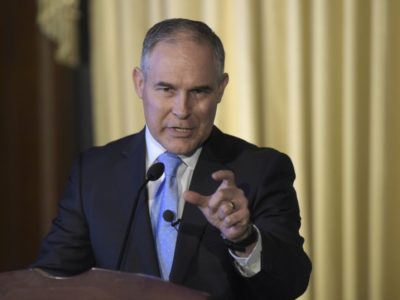Search Results for: feed
Guest Blogger Benjamin Miller: Suggestions to help EPA Successfully Implement Retrospective Reviews
On June 13th, the Environmental Protection Agency (EPA) issued an advanced notice of proposed rulemaking soliciting comments on how to improve the consistency and transparency of the cost benefit analyses that guide EPA’s regulatory decision making. Both are praiseworthy goals, particularly because executive orders issued by the Trump administration last year resulted in cost benefit analysis being used not …
CONTINUE READINGLessons From the University of California’s Carbon Neutrality Initiative
New Pritzker Brief Highlights Barriers to, Recommendations for, Getting to Zero Carbon Emissions by 2025
In 2013, University of California President Janet Napolitano announced that the system’s ten campuses and its central office would cut their carbon emissions to zero by 2025. The goal is one of the most ambitious organizational goals in the country. To help implement the Carbon Neutrality Initiative, the President appointed a Global Climate Leadership Council …
Continue reading “Lessons From the University of California’s Carbon Neutrality Initiative”
CONTINUE READINGThe importance of intra-executive branch checks and balances
We are used to thinking of the different branches of government checking each other. Scott Pruitt’s behavior illustrates the need for stronger checks and balances within the executive branch
As Dan recently pointed out, Scott Pruitt has a lot of explaining to do these days, about his housing situation last year, about his travel as EPA Administrator, about how two of his close aides ended up with hefty pay raises, and more. Even Fox News is asking questions. I want to make a different …
Continue reading “The importance of intra-executive branch checks and balances”
CONTINUE READINGThe Disagreeable Mr. Pruitt
The list of his six worst traits starts with paranoia and ends with unbounded ambition.
I’m sure that Scott Pruitt has his good side. Probably he loves dogs. But his bad traits are, well, pretty hard to overlook. Here are some of the main characteristics of the man who is now charged by statute with protecting our environment: Paranoia. As Grist says, “in just his first year, he has reportedly …
Continue reading “The Disagreeable Mr. Pruitt”
CONTINUE READINGTrump Administration to Hold California Hearing on Offshore Oil Drilling Proposal
Sacramento Hearing Likely to Be Both a Raucous and Fundamentally Flawed Affair
Legal Planet colleague Eric Biber this week has published a series of posts on the Trump Administration’s controversial–and deeply flawed–proposal to open most of the nation’s Outer Continental Shelf to offshore oil and gas development. I won’t attempt to retread the ground Eric has ably covered, but want to highlight a major upcoming and related event …
Continue reading “Trump Administration to Hold California Hearing on Offshore Oil Drilling Proposal”
CONTINUE READINGGuest Blogger Ken Alex: California’s Renewable Portfolio Standard
Post #2 in a Series on California Climate Policy by Ken Alex, Senior Policy Advisor to Gov. Jerry Brown
[This is the second post in a series expressing my view of why California’s actions on climate change are so important and how they will change the world. The introductory post provides an overview and some general context.] SB 350 (2015) requires that California’s investor and municipal owned utilities provide 50% of their customer’s electricity …
Continue reading “Guest Blogger Ken Alex: California’s Renewable Portfolio Standard”
CONTINUE READINGPineapples and Preparing for the Future at COP23
Guest post by Eric Sezgen, UCLA Law student
As Alex’s previous blogpost states, there was a sense of urgency at this COP. Urgency had observable consequences all around the conference and was not only embraced but enhanced by Fiji’s presidency. You could see this even in the COP’s logo. Whereas the COP logo is usually a sleek and trendy design to look good …
Continue reading “Pineapples and Preparing for the Future at COP23”
CONTINUE READINGThe EPA Sets in Motion its Plan to Rescind the Waters of the United States Rule
This Action is Just the First Step Towards Reducing Clean Water Act Protection for Many Waterways and Wetlands
With much fanfare, the Trump administration announced last Tuesday that it is proposing to rescind the Clean Water Rule, also known as the Waters of the United States (WOTUS) Rule. This rule is intended to govern determinations of which waterbodies and wetlands are “waters of the United States,” protected under the Clean Water Act. The …
Continue reading “The EPA Sets in Motion its Plan to Rescind the Waters of the United States Rule”
CONTINUE READINGNational Monuments Update
Interior Department releases interim report, recommends changes to Bears Ears National Monument
Interior Secretary Ryan Zinke released his interim report yesterday on Bears Ears National Monument, recommending that President Trump re-draw the monument’s boundaries. Secretary Zinke’s report misreads both the Antiquities Act and President Obama’s 2016 Proclamation that created Bears Ears National Monument, and any move by President Trump to downsize the monument without an act of Congress …
Continue reading “National Monuments Update”
CONTINUE READINGA Lame Soundbite From a Flailing Administration
Pruitt’s statement yesterday exemplifies why the Trump Administration is in trouble.
Everything that’s wrong with the Trump Administration was on display yesterday, thanks to Scott Pruitt. He told “Fox and Friends” that the U.S. should get out of the Paris Agreement because China and India have no obligations until 2030. The fact that he made this comment, and made it on Fox, vividly exemplifies many of the Administration’s …
Continue reading “A Lame Soundbite From a Flailing Administration”
CONTINUE READING







